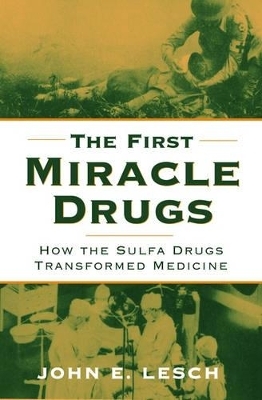
The First Miracle Drugs
How the Sulfa Drugs Transformed Medicine
Seiten
2006
Oxford University Press Inc (Verlag)
978-0-19-518775-5 (ISBN)
Oxford University Press Inc (Verlag)
978-0-19-518775-5 (ISBN)
In the decade from 1935-1945, while the Second World War raged in Europe, a new class of medicines capable of controlling bacterial infections launched a therapeutic revolution. This book examines this revolution in medicine, pharmacy, and science. It also explores the popular perceptions of the dramatic changes in medicine.
In the decade from 1935-1945, while the Second World War raged in Europe, a new class of medicines capable of controlling bacterial infections launched a therapeutic revolution that continues today. The new medicines were not penicillin and antibiotics, but sulfonamides, or sulfa drugs. The sulfa drugs preceded penicillin by almost a decade, and during World War II they carried the main therapeutic burden in both military and civilian medicine. Their success stimulated a rapid expansion of research and production in the international pharmaceutical industry, raised expectations of medicine, and accelerated the appearance of new and powerful medicines based on research. The latter development created new regulatory dilemmas and unanticipated therapeutic problems. The sulfa drugs also proved extraordinarily fruitful as starting points for new drugs or classes of drugs, both for bacterial infections and for a number of important non-infectious diseases.
This book examines this breakthrough in medicine, pharmacy, and science in three parts. Part I shows that an industrial research setting was crucial to the success of the revolution in therapeutics that emerged from medicinal chemistry. Part II shows how national differences shaped the reception of the sulfa drugs in Germany, France, Britain, and the United States. The author uses press coverage of the day to explore popular perceptions of the dramatic changes taking place in medicine. Part III documents the impact of the sulfa drugs on the American effort in World War II. It also shows how researchers came to an understanding of how the sulfa drugs worked, adding a new theoretical dimension to the science of pharmacology and at the same time providing a basis for the discovery of new medicinal drugs in the 1940s, 1950s, and 1960s. A concluding chapter summarises the transforming impact of the sulfa drugs on twentieth-century medicine, tracing the therapeutic revolution from the initial breakthrough in the 1930s to the current search for effective treatments for AIDS and the new horizons opened up by the human genome project and stem cell research.
In the decade from 1935-1945, while the Second World War raged in Europe, a new class of medicines capable of controlling bacterial infections launched a therapeutic revolution that continues today. The new medicines were not penicillin and antibiotics, but sulfonamides, or sulfa drugs. The sulfa drugs preceded penicillin by almost a decade, and during World War II they carried the main therapeutic burden in both military and civilian medicine. Their success stimulated a rapid expansion of research and production in the international pharmaceutical industry, raised expectations of medicine, and accelerated the appearance of new and powerful medicines based on research. The latter development created new regulatory dilemmas and unanticipated therapeutic problems. The sulfa drugs also proved extraordinarily fruitful as starting points for new drugs or classes of drugs, both for bacterial infections and for a number of important non-infectious diseases.
This book examines this breakthrough in medicine, pharmacy, and science in three parts. Part I shows that an industrial research setting was crucial to the success of the revolution in therapeutics that emerged from medicinal chemistry. Part II shows how national differences shaped the reception of the sulfa drugs in Germany, France, Britain, and the United States. The author uses press coverage of the day to explore popular perceptions of the dramatic changes taking place in medicine. Part III documents the impact of the sulfa drugs on the American effort in World War II. It also shows how researchers came to an understanding of how the sulfa drugs worked, adding a new theoretical dimension to the science of pharmacology and at the same time providing a basis for the discovery of new medicinal drugs in the 1940s, 1950s, and 1960s. A concluding chapter summarises the transforming impact of the sulfa drugs on twentieth-century medicine, tracing the therapeutic revolution from the initial breakthrough in the 1930s to the current search for effective treatments for AIDS and the new horizons opened up by the human genome project and stem cell research.
PART I: THE INDUSTRIAL ORIGINS OF PRONTOSIL ; PART II: THE MAKING OF THE FIRST MIRACLE DRUGS ; PART III: PRACTICE AND THEORY
| Erscheint lt. Verlag | 2.11.2006 |
|---|---|
| Zusatzinfo | 25 halftones |
| Verlagsort | New York |
| Sprache | englisch |
| Maße | 234 x 160 mm |
| Gewicht | 664 g |
| Themenwelt | Medizin / Pharmazie ► Medizinische Fachgebiete ► Pharmakologie / Pharmakotherapie |
| Studium ► Querschnittsbereiche ► Geschichte / Ethik der Medizin | |
| Studium ► Querschnittsbereiche ► Prävention / Gesundheitsförderung | |
| ISBN-10 | 0-19-518775-X / 019518775X |
| ISBN-13 | 978-0-19-518775-5 / 9780195187755 |
| Zustand | Neuware |
| Haben Sie eine Frage zum Produkt? |
Mehr entdecken
aus dem Bereich
aus dem Bereich
Die Geschichte eines Weltzentrums der Medizin von 1710 bis zur …
Buch | Softcover (2021)
Lehmanns Media (Verlag)
CHF 27,90
von der Antike bis zur Gegenwart
Buch | Softcover (2024)
C.H.Beck (Verlag)
CHF 16,80
Krankheitslehren, Irrwege, Behandlungsformen
Buch | Softcover (2024)
C.H.Beck (Verlag)
CHF 55,90


